Banco Minero drawn on the Banco de la Laguna
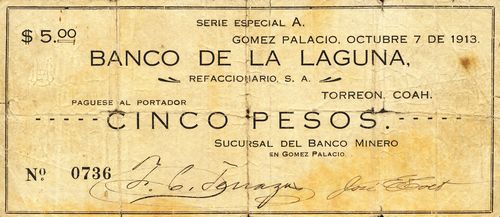
 M1463 $5 Sucursal del Banco Minero
M1463 $5 Sucursal del Banco Minero
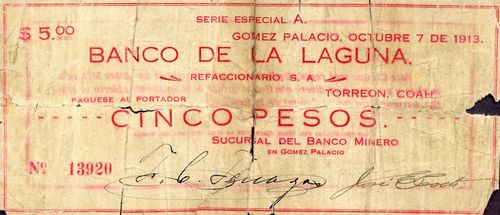
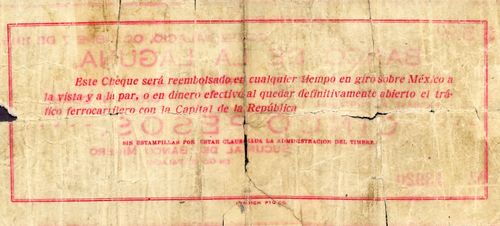 M1462 $5 Sucursal del Banco Minero
M1462 $5 Sucursal del Banco Minero
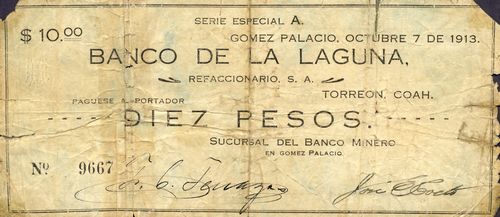
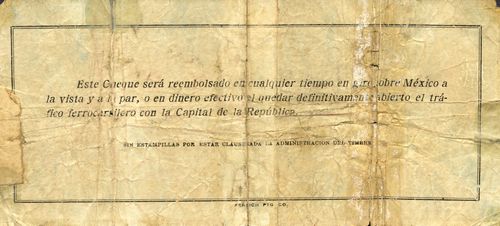 M1464 $10 Sucursal del Banco Minero
M1464 $10 Sucursal del Banco Minero
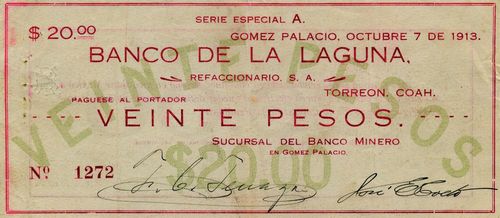 M1465 $20 Sucursal del Banco Minero
M1465 $20 Sucursal del Banco Minero
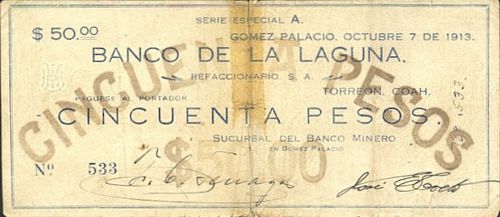 M1466 $50 Sucursal del Banco Minero
M1466 $50 Sucursal del Banco Minero
| Date on note | Series | from | to | total number |
total value |
||
| 7 October 1913 | $5 | A | printed in black includes numbers 492 to 7316} |
||||
| A | printed in red includes numbers 12283 to 24472CNBanxico #6690 |
||||||
| $10 | A | includes numbers 3942 to 14400 | |||||
| $20 | A | includes numbers 0775 to 1272CNBanxico #10874 | |||||
| $50 | A | includes number 533CNBanxico #10875 | |||||
| $ 380,000 |
These were signed by Francisco C. Terrazas and José [ ][identification needed].
|
Francisco Creel Terrazas was subcajero of the Banco Minero in Chihuahua in 1905 to 1907 and was a regidor of the ayuntamiento of Chihuahua in 1907. From 1907 he was manager of the Gómez Palacio branch. In 1911 he was elected to the board of the Banco de la LagunaEl Economista Mexicano, 29 April 1911. He also served as tesorero of the Compañía Industrial Jabonera de la Laguna. On 11 May 1912 Terrazas (together with others, including the former cajero of the Banco Minero, Francisco de P. Venzor) was arrested in Gómez Palacio by the Torreón police, accused of corresponding with the rebel OrozcoEl Imparcial, Tomo XXXII, Núm. 6617, 14 May 1912. |
 |
| José |  |
The notes state that they do not carry stamps as the stamp office was closed (SIN ESTAMPILLAS POR ESTAR CLAUSADA LA ADMINISTRACION DEL TIMBRE) but Dick Long records a $5 note (A 492) bearing Guadalajara revenue stamps on the reverse.
By 1919 some of the cheques issued by the Banco Minero and drawn on the Banco de la Laguna had still not been paid and were a matter of dispute. The dispute evolved around the date that communications were resumed between Torreón and Mexico City. Juan F. Brittingham had posited one date: Francisco C. Terrazas had replied that Brittingham was not in Gómez Palacio at the time and had got the dates wrong. His own family had left Torreón on 21 or 22 December, arriving in Saltillo a couple of days later CEHM, Fondo Creel, 244, 62488, letter Terrazas, Mexico City to Enrique C. Creel, Los Angeles, 16 October 1919 whilst Miguel Torres said that his investigation suggested the first train from Torreón to Mexico City, via Monterrey, was on 9 December CEHM, Fondo Creel, 246, 63140, letter Enrique C. Creel to Juan A. Creel, El Paso, 19 December 1919. Creel therefore believed that the period for presenting the cheques had expired, since more than three years had passed before Carranza’s moratorium. The argument appears to have been that
(a) the cheques were payable in cash once railway communications had been definitely re-established with Mexico City (en dinero efectivo al quedar definitivamente abierto el tráfico ferrocarrilero con la Capital de la República).
(b) The Código de Comercio required cheques to be presented within three years, or they lost their value
However,
(c) Carranza’s Ley del Moratorio, on 16 December 1916, suspended any expiration
So,
(d) if traffic was resumed before 16 December 1913, the cheques expired on 16 December 1916, but
(e) if traffic was resumed after 16 December 1913, Carranza’s moratorium would suspend any expiration, and the cheques would still be valid.
Enrique Creel was worried that as the Banco de la Laguna had reopened its branch in Torreón it would accept the cheques in payment and then present them to the Banco Minero for honouring. However, Francisco C. Terrazas felt that the amount still outstanding was very small as most were used by the revolutionary troops for expenses and the rest would have been destroyed during the following disturbances CEHM, Fondo Creel, 244, 62464, letter Francisco C. Terrazas, Mexico City to Enrique C. Creel, Los Angeles, 23 December 1919.
Terrazas reported that the bank had issued $380,000 in cheques de Banco a Banco, and had retired $300,000CEHM, Fondo Creel, 149, 38352, report on Banco Minero by Francisco C. Terrazas.
